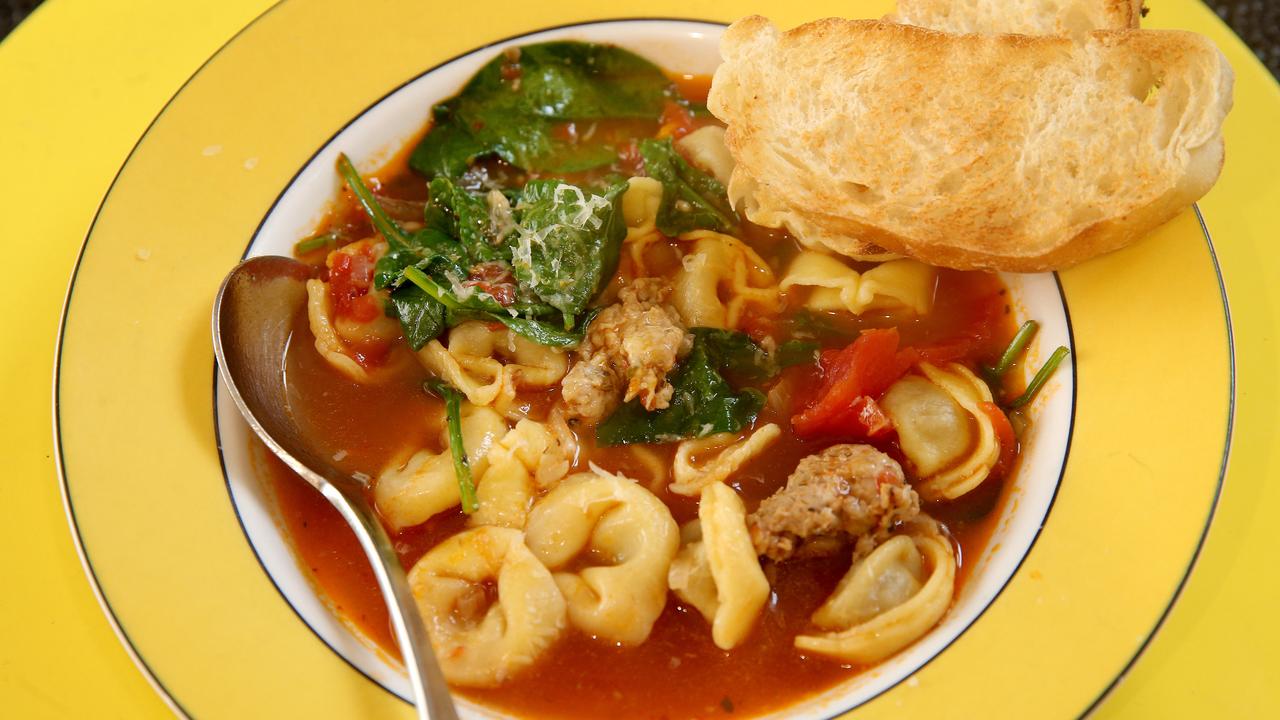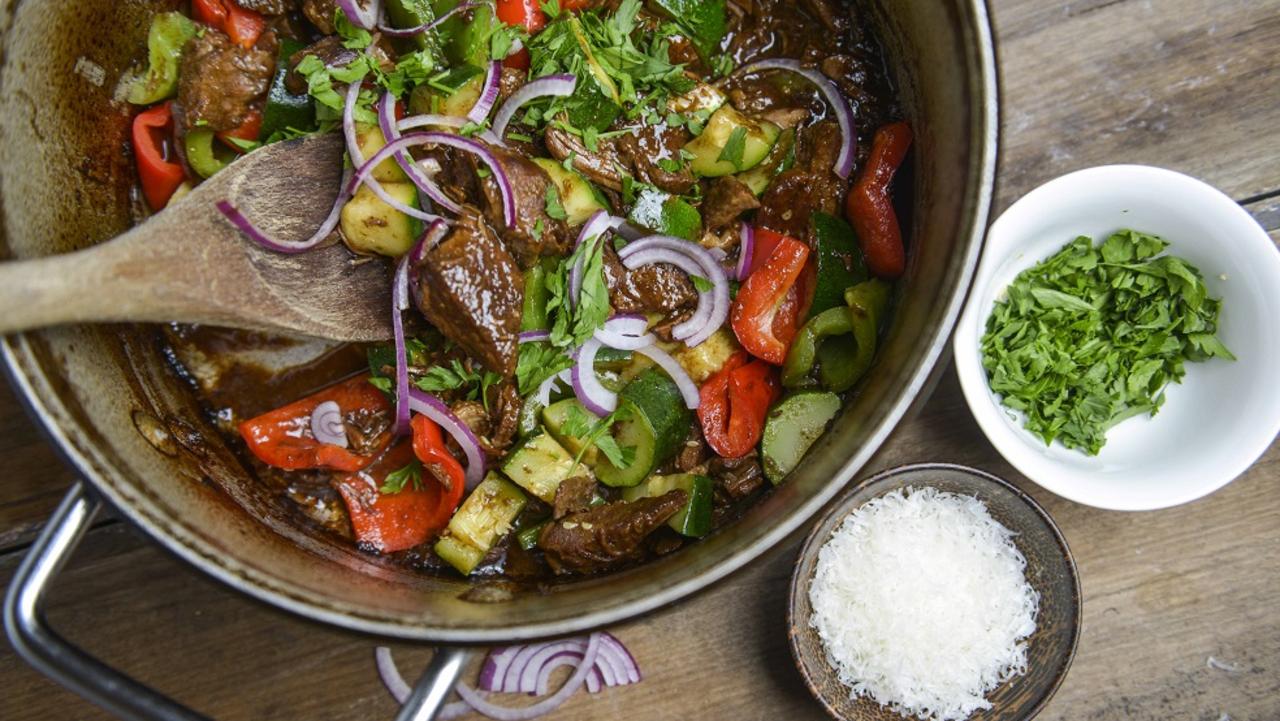Tortellini soup with a tomato and sausage base
Making soup is almost as comforting as eating it. This recipe is hearty and full of flavour, and it comes together in no time.

MAKING soup is almost as comforting as eating it — and having a pot of it simmering on the stove is one of the most comforting parts of cooking during the cooler months.
The great thing about some soups is that they can be built into a one-dish meal, perfect for huddling round the fire or nestling in front of television.
TORTELLINI SOUP
Here’s a satisfying soup for chilly nights. Hearty and full of flavour, it comes together in no time. Serve it with crusty bread to sop up every last bit.
Serves 4-6
2 tbsp olive oil
4 average-sized Italian-style sausages, casings removed
½ medium onion, diced
2 cloves garlic, chopped
¾ tsp dried oregano
6 cups chicken stock
400ml tin crushed tomatoes
350 fresh or frozen tortellini (choose the filling of your choice)
6 lightly packed cups baby spinach
Salt and freshly ground black pepper
Grated parmesan cheese, for serving
Crusty bread (optional)
Heat the oil in large saucepan over medium-high heat. Add the sausage meat and onion, and cook, stirring occasionally, breaking the sausage meat into small pieces, until it is cooked through and starting to brown. Add the garlic and oregano, and cook until fragrant, about 30 seconds.
Add the stock and tomatoes, raise the heat to high, and bring to a boil. Add the tortellini, lower the heat to a simmer, and cook according to package directions until the pasta is tender, 3 to 5 minutes. Stir in the spinach, and cook just until wilted. Season to taste with salt and pepper, and serve sprinkled with the cheese and with crusty bread.
MORE:
SOUP’S UP
DOUBLE your recipe. Soups are easy to make in large batches, and are one of the most freezer-friendly dishes around. So, double up on ingredients, grab a larger saucepan and make two meals instead of one.
SWEAT the vegetables properly. To make a good soup, you have to build flavours as you go. Vegetables such as onion, garlic, celery and carrots — the aromatics — are part of most soup recipes for this very reason, sauteed in oil or butter as a first step of flavour making. Be sure they’re cooked long enough to be softened (and release their flavour) before moving on to the next step.
CONSIDER each ingredient’s cook time. A pea will cook much faster than a cube of carrot. Stagger the addition of vegetables so that they’re all finished cooking as close together as possible.
MAKE it easier to eat. When chopping vegetables, think about how big you want them to be on the spoon. Even hearty, rustic soups should have well-chopped, reasonably sized vegetables. Greens such as spinach and kale also need to be chopped, or they will be difficult to eat, even if they wilt during the cooking process.
GO EASY on the salt. Depending on the ingredients you’re adding, you don’t always know how much salt is going in. Many commercial stocks have high levels of sodium, as do tinned beans, vegetables and tomato paste. For this reason, save most of your seasoning until the end, then taste and adjust as needed.
MAKE the stock count. When it comes to making clear soups, the stock that you use is the most important ingredient. Poorly flavoured stock can ruin the entire pot of soup. For clear soups, homemade stock is always the best choice. If that’s not an option for you, purchase stock from a butcher or poultry store.
SLOW and steady. Once soup has come to a boil, reduce to a simmer and make sure that it stays there. Boil things too vigorously, and the vegetables will get mushy, meat components will toughen, and noodles will start to break down.
ALL in together. When making noodle-based soups, do not cook the noodles separately. Add the noodles as the final addition, and cook until tender, allowing the noodles to take on the flavour of the soup. Noodles that are cooked separately will lack flavour and break down when added. However, if you plan on freezing your soup, don’t add the noodles. Instead add them once it has been thawed and brought back to a boil. The noodles will taste much fresher this way.
FANCY a bit of cream or milk? Creamy soups are generally thicker than clear soups — but shouldn’t be too thick. The consistency of whipping cream is the thickest they should be. Ideally, cream should be warmed before adding to soup to prevent curdling. Cold milk may curdle if added directly to a simmering soup, so it too should be warmed. Milk also doesn’t react well to boiling. If adding milk (in place of cream) to thicken the soup, take a moment to anticipate how much it will thin it out once added. When ready, remove soup from heat and stir in warm milk.
COOL before chilling. Let hot soups cool at room temperature, uncovered for 1 to 1½ hours, or until almost at room temperature. Cover and refrigerate until cold. Soups can last in the fridge for up to three days. Freeze soups after they have been chilled overnight in the fridge. Most soups will last up to two months in the freezer.



